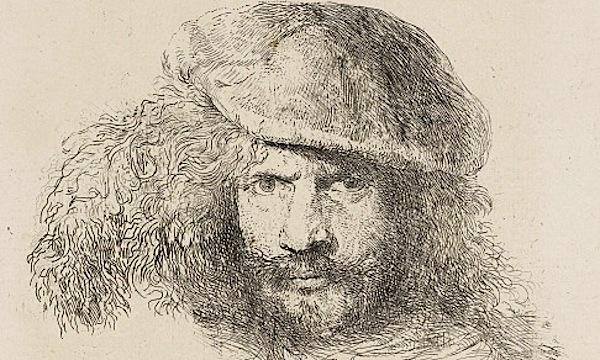The Queen’s Gallery at Buckingham Palace will stage the UK’s first major exhibition of Giovanni Benedetto Castiglione, this Autumn. Through 90 drawings and prints from the Royal Collection, which compile the largest and finest group of the artist’s work, the exhibition aims to reinstate Castiglione in his rightful place as one of the greatest artists of the Baroque.
Castiglione was among the most innovative draughtsman of the 17th century. Yet Giovanni Benedetto Castiglione (1609-64) was also a violent and impetuous man, who was repeatedly in court for assault, allegedly attempted to throw his sister off a roof and was forced to leave Rome, probably after committing murder. The turbulence that characterised his life overshadowed his artistic brilliance, and Castiglione struggled to achieve recognition in his lifetime. Much of what is known about the artist is derived not from fulfilled commissions, but from court documents.
Castiglione’s body of work is unique in the 17th century. He made huge drawings in oil, working directly on to paper without any of the customary preparation. These dynamic compositions, quite exceptional for their time, were conceived as finished works of art, despite their spontaneous and almost rough appearance. Castiglione was also one of Italy’s most significant printmakers and produced around 60 etchings. He invented the technique of monotype, drawing in oils or printer’s ink on to a metal plate and then taking a single impression on a sheet of paper. This strikingly modern hybrid of drawing, painting and printmaking was adopted by artists such as Degas and Gauguin some 200 years later.
Castiglione trained in the cosmopolitan port of Genoa in north-west Italy. His early reputation was based on his skill in depicting pastoral subjects, particularly lyrical scenes of shepherds and animals in fertile landscapes. A study of camels and goats from c.1630, probably his earliest surviving work, would have been drawn from stock motifs – camels were not to be found in even as cosmopolitan a city as Genoa. As his ambitions grew, Castiglione began to tackle grander themes of religion, mythology, legend and allegory that belie the darker undercurrents of his personality.
In 1646, Castiglione was on the verge of becoming Genoa’s leading painter, but jeopardised all in an instant. On hearing that the Doge of the Venetian Republic, Giovanni Battista Lomellini, had been advised to turn down a painting commissioned from him, Castiglione slashed the work to shreds and swore that his patron would receive nothing more. He then left the city disguised as an Armenian in a black cassock and a brimless stovetop hat.
Castiglione’s career led him to Rome, Florence, Naples, Venice and finally Mantua. His nomadic life brought him into contact with artists from all over Europe, most notably Anthony van Dyck in Genoa and the French artist Nicolas Poussin in Rome. Magpie-like, he absorbed a variety of stylistic influences and often borrowed motifs or even entire compositions. In a coloured oil drawing from the 1630s, he translates the Renaissance subtlety of Titian’s Sacred and Profane Love (1514) into a theatrical Baroque style. Castiglione is the first artist in Italy known to have borrowed directly from Rembrandt, and his etchings were heavily influenced by the natural expressiveness of the Dutch artist’s work. In a sheet of Studies of heads from the 1630s, Castiglione has clearly adapted two figures from Rembrandt’s etching Ecce Homo of 1636.
Castiglione’s powerful Head of an oriental from the late 1640s is among the finest of his monotype prints. Having drawn the image on the plate with sticky ink, the artist scraped into the surface to highlight details of the sitter’s turban, beard and fur collar. Reversing the process, Castiglione would sometimes cover the plate entirely with ink and then scrape the design into it, producing the dramatic contrasts of light and dark seen in The Nativity with angels (c.1655).
Castiglione’s greatest and most distinctive works are his large oil drawings, often executed in warm reddish-brown tones. He used the medium in a variety of ways, from a thin transparent wash that soaks into the paper, to a thick, opaque, almost dry pigment to pick out details. His finest drawings, among them Circe with the companions of Odysseus transformed into animals and the allegory of transience, Omnia vanitas, are among the most original and exciting works on paper of the entire Baroque.
Towards the end of his life, Castiglione achieved some sort of stability as a court artist to the Gonzagas, the dukes of Mantua. He died in the city in 1664, leaving hundreds of drawings in his studio, and it is likely that the works eventually passed into the Gonzaga collections. By the early 1700s the cache of Castiglione’s drawings had found their way to Venice, where his work was rediscovered by a new generation of artists, particularly Giambattista Tiepolo.
Collectors now competed for Castiglione’s drawings, and the artist finally gained an artistic reputation that he had struggled to achieve in his lifetime. In 1762 a group of 250 sheets by Castiglione was acquired by George III, as part of the collection of Joseph Smith, British Consul in Venice. Castiglione’s posthumous celebrity was short lived, however, and a century later he fell from fame – his highly original and improvised techniques at odds with the restrained classical taste of this time.
Castiglione: Lost Genius is at The Queen’s Gallery, Buckingham Palace, 1 November 2013 – 16 March 2014, with Gifted: From the Royal Academy to The Queen.

